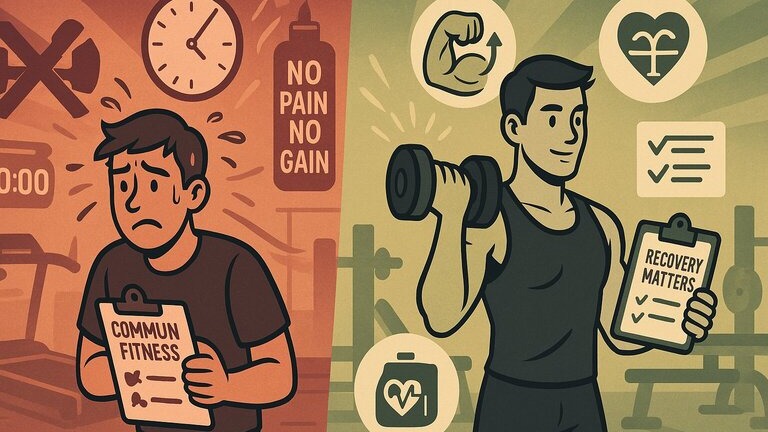
Challenging Common Misconceptions in Fitness
Fitness advice can often be misleading, leading enthusiasts to adopt routines that don't yield the desired outcomes.
A recent video titled Fitness Advice EVERYONE Gets Wrong (And What To Do Instead!) highlights several prevalent myths that can undermine workout effectiveness and proposes practical alternatives for maximizing gains.
Misconceptions about muscle recovery, workout intensity, and the role of cardio are particularly critical, influencing how both novice and seasoned gym-goers approach their training.
In Fitness Advice EVERYONE Gets Wrong (And What To Do Instead!), the discussion dives into fitness myths that mislead individuals, exploring key insights that sparked deeper analysis on our end.
The Myth of Muscle Damage
One widely believed notion in strength training is that creating more muscle damage leads to greater gains.
This misconception stems from the idea that pushing oneself to extreme fatigue, using techniques like drop sets or giant sets, is the key to muscle growth.
However, as highlighted in the video, recovery through muscle protein synthesis actually diminishes when one over-trains.
Instead, maintaining a consistent effort at moderate levels of intensity, while allowing adequate recovery, fosters better long-term growth.
Progressive Overload Reinterpreted
Another point of confusion is the notion of progressive overload that has gained traction within fitness circles. Many individuals feel pressured to increase weights or repetitions in every session to see progress.
In reality, progressive overload refers to the body's natural adaptation process over time. Athletes often experience plateaus where gains may appear stagnant.
Embracing patience and understanding that consistent stimulus without the immediate gratification of increased weights is vital for muscle development can reshape one's approach to training.
The Impact of Cardio on Strength Gains
There is a pervasive belief that cardio negatively impacts strength gains, a notion rooted in the so-called 'interference effect.'
The video presents a more nuanced view, emphasizing that while cardio can reduce muscle-building signals to some extent, its benefits extend beyond muscle growth, supporting heart health and overall fitness.
To balance both strength and endurance training, one effective strategy is to separate cardio sessions from weightlifting or perform cardio after lifting.
Incorporating lower-impact cardio can help mitigate the potential loss of strength while improving overall fitness.
Also, nutrition and exercise myths often go hand in hand.
Individualized Training Techniques
The idea that there is a single 'correct' form of lifting has led many athletes to adopt techniques that may not suit their individual body mechanics.
The video encourages viewers to recognize their unique physical attributes and to adapt exercises accordingly. What works for one individual may lead to injury or inefficiency for another.
The focus should be on identifying personal strengths and weaknesses rather than conforming to one-size-fits-all protocols.
Tailoring your routine can lead to more effective workouts and greater overall health.
Beyond the Surface: Emotional Connections to Training
For many, fitness is not just about the physical aspect; it also influences mental health and emotional well-being.
The pressures of adhering to mainstream fitness trends can lead to feelings of inadequacy when results do not meet expectations.
Acknowledging the psychological barriers associated with training is equally crucial. Being aware that progress is not linear and that patience plays a key role can help alleviate stress.
It fosters a more sustainable view of fitness and allows individuals to enjoy their journey rather than spiraling into discouragement.
Your Path Forward: Insights from the Video
By examining the insights from the video, readers are encouraged to reevaluate their training strategies.
Too many individuals in the Sacramento area may feel trapped by conventional wisdom; however, the shift towards individualized training techniques and a focus on management of muscle fatigue can unlock greater potential.
Adopting a balanced approach and recognizing personal limits can lead to a healthier relationship with gym routines.
Conclusion: The Journey to Fitness Realizations
As fitness cultures evolve, it is essential for enthusiasts to remain informed and analytical about the advice prevalent in their communities.
By understanding and overcoming common misconceptions, Sacramento gym-goers can navigate their fitness journeys with renewed confidence and efficacy.
Let’s reshape our workout narratives while prioritizing progress and enjoyment. For deeper engagement, consider sharing your fitness journey and what strategies have successfully worked for you.
Looking for more fitness inspiration? Visit our Fitness Focus section — and check out other wellness categories on Sacramento Living Well.
---
Authored by the Sacramento Living Well Editorial Team — a publication of DSA Digital Media, dedicated to highlighting wellness, local living, and inspiring community stories throughout Greater Sacramento.
 Add Row
Add Row  Add
Add 





Write A Comment